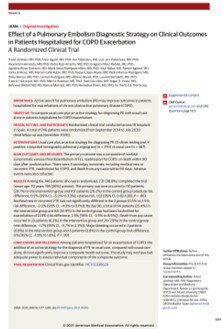David Jiménez, Alvar Agustí, Eva Tabernero, et al. Effect of a Pulmonary Embolism Diagnostic Strategy on Clinical Outcomes in Patients Hospitalized for COPD Exacerbation: A Randomized Clinical Trial
JAMA. 2021
"Among patients hospitalized for an exacerbation of COPD, an active strategy for the diagnosis of PE does not significantly improve health outcomes" Dr. David Jiménez.
Summary:
Importance: Active search for pulmonary embolism (PE) may improve outcomes in patients hospitalized for exacerbations of chronic obstructive pulmonary disease (COPD).
Objective: To compare usual care plus an active strategy for diagnosing PE with usual care alone in patients hospitalized for COPD exacerbation.
Design, setting, and participants: Randomized clinical trial conducted across 18 hospitals in Spain. A total of 746 patients were randomized from September 2014 to July 2020 (final follow-up was November 2020).
Interventions: Usual care plus an active strategy for diagnosing PE (D-dimer testing and, if positive, computed tomography pulmonary angiogram) (n = 370) vs usual care (n = 367).
Main outcomes and measures: The primary outcome was a composite of nonfatal symptomatic venous thromboembolism (VTE), readmission for COPD, or death within 90 days after randomization. There were 4 secondary outcomes, including nonfatal new or recurrent VTE, readmission for COPD, and death from any cause within 90 days. Adverse events were also collected.
Results: Among the 746 patients who were randomized, 737 (98.8%) completed the trial (mean age, 70 years; 195 [26%] women). The primary outcome occurred in 110 patients (29.7%) in the intervention group and 107 patients (29.2%) in the control group (absolute risk difference, 0.5% [95% CI, -6.2% to 7.3%]; relative risk, 1.02 [95% CI, 0.82-1.28]; P = .86). Nonfatal new or recurrent VTE was not significantly different in the 2 groups (0.5% vs 2.5%; risk difference, -2.0% [95% CI, -4.3% to 0.1%]). By day 90, a total of 94 patients (25.4%) in the intervention group and 84 (22.9%) in the control group had been readmitted for exacerbation of COPD (risk difference, 2.5% [95% CI, -3.9% to 8.9%]). Death from any cause occurred in 23 patients (6.2%) in the intervention group and 29 (7.9%) in the control group (risk difference, -1.7% [95% CI, -5.7% to 2.3%]). Major bleeding occurred in 3 patients (0.8%) in the intervention group and 3 patients (0.8%) in the control group (risk difference, 0% [95% CI, -1.9% to 1.8%]; P = .99).
Conclusions and relevance: Among patients hospitalized for an exacerbation of COPD, the addition of an active strategy for the diagnosis of PE to usual care, compared with usual care alone, did not significantly improve a composite health outcome. The study may not have had adequate power to assess individual components of the composite outcome.
Trial registration: ClinicalTrials.gov Identifier: NCT02238639.
Why do you highlight this publication?
For the first time, a RCT has assessed the efficacy and safety of an active diagnostic strategy for PE in patients who require hospitalization for exacerbation of COPD.
Publication commented by:
Dr. David Jiménez Castro
RESPIRATORY DEPARTMENT AND MEDICINE DEPARTMENT. HRC
RESPIRATORY DISEASES. IRYCIS



